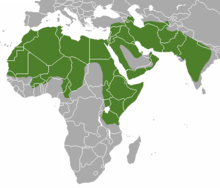Striped hyena
| Striped hyenas Temporal range: 0.7–0 Ma – Recent |
|
|---|---|
 |
|
| Striped hyena at a zoo in Nepal | |
| Scientific classification | |
| Kingdom: | Animalia |
| Phylum: | Chordata |
| Class: | Mammalia |
| Order: | Carnivora |
| Family: | Hyaenidae |
| Genus: | Hyaena |
| Species: | H. hyaena |
| Binomial name | |
|
Hyaena hyaena (Linnaeus, 1758) |
|
 |
|
| Striped hyena range | |
| Synonyms | |
|
Canis hyaena Linnaeus, 1758 (numerous others)
|
|
The striped hyena (Hyaena hyaena) is a species of hyaena native to North and East Africa, the Middle East, the Caucasus, Central Asia and the Indian subcontinent. It is listed by the IUCN as near-threatened, as the global population is estimated to be under 10,000 mature individuals which continues to experience deliberate and incidental persecution along with a decrease in its prey base such that it may come close to meeting a continuing decline of 10% over the next three generations.
It is the smallest of the true hyenas and retains many primitive viverrid characteristics lost in larger species, having a smaller and less specialised skull. Though primarily a scavenger, large specimens have been known to kill their own prey, and attacks on humans have occurred on rare instances. The striped hyena is a monogamous animal, with both males and females assisting one another in raising their cubs. A nocturnal animal, the striped hyena typically only emerges in complete darkness, and is quick to return to its lair before sunrise. Although it has a habit of feigning death when attacked, it has been known to stand its ground against larger predators in disputes over food.
The striped hyena features prominently in Middle Eastern and Asian folklore. In some areas, its body parts are considered magical, and are used as charms or talismans. It is mentioned in the Hebrew Bible, where it is referred to as tzebua or zevoa, though the species is absent in some Bible translations into English.
The species may have evolved from H. namaquensis of Pliocene Africa. Striped hyena fossils are common in Africa, with records going back as far as the Middle and even to the Villafranchian. As fossil striped hyenas are absent from the Mediterranean region, it is likely that the species is a relatively late invader to Eurasia, having likely spread outside Africa only after the extinction of spotted hyenas in Asia at the end of the last glacial period. The striped hyena occurred for some time in Europe during the Pleistocene, having been particularly widespread in France and Germany. It also occurred in Montmaurin, Hollabrunn in Austria, the Furninha Cave in Portugal and the Genista Caves in Gibraltar. The European form was similar in appearance to modern populations, but was larger, being comparable in size to the brown hyena.
...
Wikipedia

